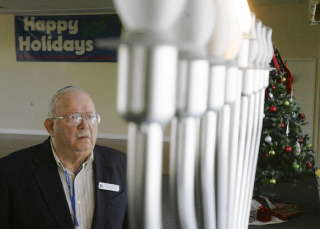|
Article
Courtesy of The Orlando Sentinel By Joseph
Freeman Published
December 25, 2011
LEESBURG — The menorah inside the social hall of a Lake
County retirement community costs more than a flat-screen TV and is taller than
the average man.
The 61/2-foot, $1,000 candelabra at Legacy of Leesburg
resulted from a legal settlement after a rabbi who lives in the community
complained to the homeowners association that the tiny menorah on a table in the
hall was dwarfed by a much-larger Christmas tree.
"I felt that it was unfair," said Rabbi Arthur
Grae of Leesburg's Congregation Or Chayim, who has lived at the development on
U.S. Highway 27 since 2005.
The oversized menorah, which like all others has nine branches for lights or candles, was in place for the start of Hanukkah this week, though hard feelings linger about how it got there. The case threatened to turn the Festival of Lights — another name for the Jewish holiday — into the Festival of Fights.
The disagreement started over decorations. Every time Grae drove over to the social hall, he passed holiday wreathes on lampposts and doors, lights strung on bushes and plywood animals that he referred to in the lawsuit as "cavorting reindeer" on the front lawn.
In August, the homeowners association rejected a proposal from Grae and others to purchase a 61/2-foot aluminum menorah that lights up when plugged in and place it outside the social hall. |
|
Rabbi
Arthur Grae and his fellow Jewish members sued the homeowners association
of the Legacy of Leesburg retirement community in Lake County over
displaying a menorah.
|
Board members thought that buying and moving it there would necessitate hauling out the Christmas tree as well so equal attention is paid to both holidays.
They also insisted that most of the decorations, such as the wreathes and reindeer, were generic seasonal items and not religious symbols. Instead, the association voted to buy a standard-sized menorah, usually a little more than a foot high, to replace the one already on display.
Todd Koechlein, the homeowners-association president, viewed the decision as a good compromise that would please everybody. Grae, who before retiring spent his career as a New York lawyer specializing in labor and constitutional law, didn't see it that way and filed suit in circuit court. He and three other plaintiffs viewed the refusal to purchase and put in their menorah as a violation of the right to freely exercise their religion.
"It's a question of recognition of the Jewish people as equal in the eyes of the law, and equal as residents of Legacy," Grae said.
When Koechlein learned that a lawsuit had been filed with the aim of making the homeowners association install the giant menorah outside, he was stunned.
"The surprising thing to me is that we have Jewish members on the board, and the board vote was a unanimous vote," Koechlein said. "And I've never heard anybody complain or even talk about their religion and relationship to the community."
The parties reached a settlement last month that gave Grae what he wanted: the large menorah, paid for by the plaintiffs and placed where the previous display had been: indoors.
The Leesburg tiff isn't the first over proportional holiday displays. In 2007, some Long Beach, N.Y., residents complained when a 7-foot-tall Christmas tree was planted next to a 20-foot-tall menorah in front of City Hall. The city quickly found a 20-foot tree to end the discrepancy.
Residents at Legacy of Leesburg, on both sides of the issue, are less concerned with constitutional aspects of the lawsuit than the rift it has caused between neighbors and friends.
Grae wasn't welcome to attend the Hanukkah party Tuesday at the social hall, where residents marked the beginning of the eight-day celebration with the menorah he helped bring about.
One of his fellow plaintiffs, Marc Nacson, said the lawsuit was "a last resort." He invited neighbors to the party for the first night of Hanukkah to try to heal any festering resentment and let bygones be bygones. He said about 75 people, many of whom weren't Jewish, showed up for the lighting of the new menorah.
"Let's go back to some sort of normalcy and brotherhood. This is what we're all about."
|
